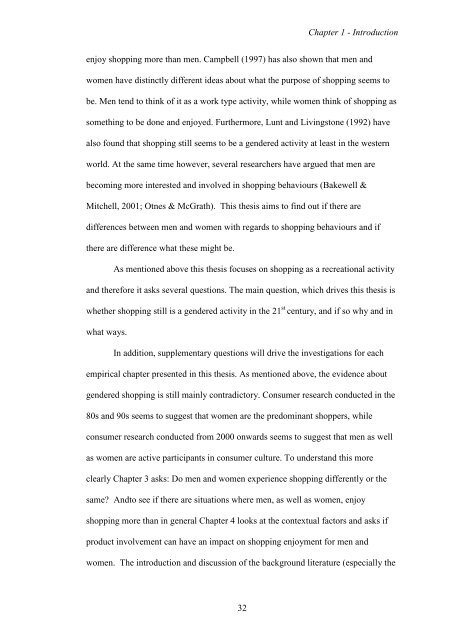CHAPTER 1 - University of Exeter
CHAPTER 1 - University of Exeter
CHAPTER 1 - University of Exeter
Create successful ePaper yourself
Turn your PDF publications into a flip-book with our unique Google optimized e-Paper software.
32<br />
Chapter 1 - Introduction<br />
enjoy shopping more than men. Campbell (1997) has also shown that men and<br />
women have distinctly different ideas about what the purpose <strong>of</strong> shopping seems to<br />
be. Men tend to think <strong>of</strong> it as a work type activity, while women think <strong>of</strong> shopping as<br />
something to be done and enjoyed. Furthermore, Lunt and Livingstone (1992) have<br />
also found that shopping still seems to be a gendered activity at least in the western<br />
world. At the same time however, several researchers have argued that men are<br />
becoming more interested and involved in shopping behaviours (Bakewell &<br />
Mitchell, 2001; Otnes & McGrath). This thesis aims to find out if there are<br />
differences between men and women with regards to shopping behaviours and if<br />
there are difference what these might be.<br />
As mentioned above this thesis focuses on shopping as a recreational activity<br />
and therefore it asks several questions. The main question, which drives this thesis is<br />
whether shopping still is a gendered activity in the 21 st century, and if so why and in<br />
what ways.<br />
In addition, supplementary questions will drive the investigations for each<br />
empirical chapter presented in this thesis. As mentioned above, the evidence about<br />
gendered shopping is still mainly contradictory. Consumer research conducted in the<br />
80s and 90s seems to suggest that women are the predominant shoppers, while<br />
consumer research conducted from 2000 onwards seems to suggest that men as well<br />
as women are active participants in consumer culture. To understand this more<br />
clearly Chapter 3 asks: Do men and women experience shopping differently or the<br />
same? Andto see if there are situations where men, as well as women, enjoy<br />
shopping more than in general Chapter 4 looks at the contextual factors and asks if<br />
product involvement can have an impact on shopping enjoyment for men and<br />
women. The introduction and discussion <strong>of</strong> the background literature (especially the
















